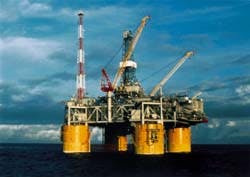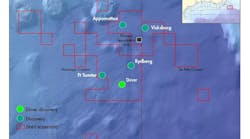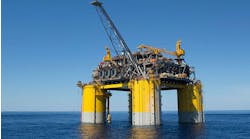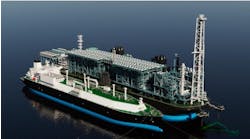Majors' development, deepwater work will drive demand for drilling, workover
James Dodson
James K. Dodson Co.
Leonard LeBlanc
Editor
Production from Shell's Auger field in the US Gulf of Mexico may soon reach 60,000 b/d of oil, far more than the 46,000 b/d originally expected. Shell will concentrate funding on development during 1995 and 1996 and less on exploration.
- Table: The top 40 operators in the US Gulf are ranked above by wells drilled in 1993 and anticipated for 1994 and 1995, based on announcements and well permits. P= projected; F= forecast.
- Table: Current platforms installed by water depth as of December 1994 with slot capacities in excess of five wells.
- Table: Average daily gas production per well in the US Gulf by year first produced (1988-1993) versus subsequent years.
- Table: Average daily oil production per well in the US Gulf by year first produced (1988-1993) versus subsequent years.
Drilling and development in the US Gulf of Mexico will show continued strength through 1995 and 1996, unless a prolonged drop in oil and gas prices undermines the recovery that began in late 1993.
Producers are expected to drill 5% more wells in 1995, according to company announcements and wells planned for exploration and development filed through October, 1994. The 5% increase will come on top of the 9% gain in drilling in 1994 over 1993.
Five circumstances continue to support a continued expansion of activity in the US Gulf:
- Profits at $1.75: The threshold for natural gas profitability has dropped into the $1.75-1.95/Mcf range, a situation that makes the industry less sensitive to gas price collapse.
- Well output declining: Natural gas output on an average per-well basis has slipped by 40% since 1987 (see Table 3), requiring a greater number of successful drilling efforts to replace that lost volume. Over 70% of the drilling in the US Gulf has been in pursuit of gas reserves.
- Deepwater viable now: Expanding deepwater exploration and development are being driven not only by expiring acreage, but good reservoir prospectivity and development confidence.
- More re-completions: Production from adjacent reservoirs and deeper strata is only short term (averaging about one year for gas and three years for oil), so producers cannot slack off workover and re-completion efforts on existing facilities.
- Development increasing: Major operators have filed a much larger number of development plans, compared with that filed in late 1993, indicating a strong first half of 1995 in terms of delineation and platform drilling.
Drilling rebound
After drilling plunged to a 30-year low of 450 wells in 1992, as a result of low oil and gas prices and capital flight, the US Gulf of Mexico was thought to be experiencing the long-expected decline from which it would not recover.
Drilling rebounded to 838 wells in 1993, and rose further to 915 wells in 1994 (see Table 1), based on rising gas and oil prices and improved deepwater and subsalt prospects.
By the end of October 1994, US Gulf majors and independents had filed plans for 586 development wells with the US Minerals Management Service, up 53% from the 382 wells filed by the same time in 1993. Of the 586 development plans, about 65% have been filed by the top 10 operators, a group made up largely of majors and large independents.
What may be more significant about the large number of plans filed is that the leases listed for development were from sales held in the mid to late 1970s. This suggests that most were held for production (Order 4) but not considered economic until operators were able to drive costs down with 3D reservoir modeling, directional drilling, and minimum platforms. Exploration wells planned through October 1994 amounted to 846, a 5% increase over 1993.
Deepwater economics
One of the remarkable reverses in US Gulf activity is the improved economics in deepwater development, and the higher drilling numbers expected in deepwater in the 1995-1996 period. Shell, a leader in deepwater exploration, has said that while 1995 development efforts will force them to rein in exploration drilling, 1996 will see a return to the deepwater search. There are four factors driving the deepwater play:
- Expiring leases: Most deepwater tracts leased in the late 1980s are due to expire in the 1995-1996 period, and many have not been drilled. Producers will be forced to surrender large blocks of undrilled acreage otherwise, and given the results of the Auger and Ram Powell discoveries, that may not be a wise move.
- Reservoir success: Most of the developments in deepwater are showing good profitability, especially if crude oil prices remain above $17/bbl. Shell Offshore's production from the Auger development in deepwater is already 50% above the expected maximum production range. Two other developments, Mars and Ram Powell, are expected to provide even stronger evidence of high per-well productivity for reservoirs in deepwater.
- Technical competence: Although the problems to be overcome in deepwater, especially hydrates and paraffins, are significant, the solutions are becoming obvious and reachable. Multi-operator investigations, such as Deepstar and Procap 2000, and experience from operators such as Petrobras, Shell, and Exxon are helping to qualify and quantify the problems and solutions.
- Royalty holiday: US legislation providing for a deepwater royalty holiday (postponement of royalty payments to government until expenses are recovered) is still on the congressional agenda. The chances of passage are more likely now with Republican control of Congress.
- Shell Offshore alone has over 387 tracts under lease in deepwater, most undrilled, and will not be able to pull back on exploration much if they are to have a chance at evaluating most of them.
Gas drilling
The year 1993 was the first in recent history of the US Gulf of Mexico in which operators discovered as much natural gas as they produced during the year. Operators added 4.5 Tcf to reserves, exactly the volume produced.
In contrast with the past, major operators are more inclined to pursue gas, alongside independents. If gas production continues to climb, there is a point of concern to gas producers and transporters. The infrastructure moving gas across the continental shelf has reached capacity in some areas. In order to increase capacity in the US Gulf, operators and/or gas transporters will either have to install more pipelines or more compression, or both.
Currently, most gas reserves being booked in the US Gulf are in one area - Mobile Bay. The remaining reserve additions are coming from existing fields where wells were deepened or operators were successful in locating adjacent production reachable with horizontal wells.
Deep cycles in natural gas prices are keeping down potential interest in new gas exploration in the US Gulf. Most gas exploration is conducted by independent operators, who must reduce drilling when investment dries up and cash flow dwindles.
Deepwater gas would add substantially to reserve figures in the future if operators can economically tie-in the production to the existing pipeline infrastructure. Shell Offshore is already developing a deepwater gas discovery by using subsea completions tied back to an existing deepwater production facility. Other operators are looking at doing the same, if only to save existing platform and pipeline infrastructure.
Gas prices
The fact that profitability is obtainable by gas producers when gas prices slide upward past the $1.75 threshold, instead of $2.50 as experienced as recently as four years ago, explains moderate drilling levels in the face of $1.40-1.70/Mcf prices.
The lower profit threshold is a product of technology. 3D has played a significant role in lowering dry hole costs. Gas drilling is more sensitive to dry hole costs than oil wells. There are other situations contributing to a lower profit threshold:
- Turnkey drilling, which offers predictable drilling costs, a key factor in multi-well gas developments and investor interest.
- Directional drilling, which has allowed operators to reach adjacent reserves from existing production structures.
- Platforms-on-demand, which allows an operator with discoveries in less than 300-ft water depths to bring a discovery onstream within months.
When gas prices return to the $2.00/Mcf level in future months, operators are expected to greatly expand drilling plans. In prior years, this did not occur until gas prices reached the $2.50/Mcf mark. Factors controlling natural gas prices, such as demand and storage, are now more measurable, allowing producers to match drilling with levels of need.
US Gulf investment
A key factor in US Gulf gas drilling investment is the value added margin between the purchase price of gas and the burner tip price. A producer sales price of $1.75/Mcf and a burner tip price of $7/Mcf leaves the transporters, storage contractors, and distributors with a tidy sum of $5.25/Mcf margin to place against their costs.
This explains why natural gas producers have attempted to move downstream to capture more of the storage and transportation margin share, and transporters and distributors to move upstream to gain assurance of supply and keep margins as high as possible.
For this same reason, US Gulf investment in gas exploration and development is coming increasingly from the downstream segment of the business. Major producers tend to fund their drilling with internal cash flow. Independents need the outside investment.
Other factors playing a role in increasing outside investment in the US Gulf are technology and cost predictability. 3D seismic is now becoming a condition for investment.
Turnkey drilling offers a means of guaranteeing the drilling cost, regardless of circumstances. The market reflects this factor, since one-third of all wells now are drilled turnkey. Quick development also provides the kind of quick return that investors like to see.
Oil drilling
Oil production has remained steady in the US Gulf, but reserves are continuing to slide, and remain far below production replacement volumes. Years of wildcat exploration and infill drilling have located all of the large, easy to drill, or shallow accumulations, leaving behind small stratigraphic or deep reserves that are difficult to image and expensive to drill.
If the slide in oil production can be stopped, it rests largely with subsalt reserves on the shelf and slope and deepwater reservoirs beyond the 2,000 ft water depth contour. Oil reserves remaining outside of subsalt accumulations on the continental shelf can be recovered in the future when 3D imaging provides greater certainty of the presence and volumes of hydrocarbon liquids.
Unless operators begin raising reserve levels beyond what has been booked over the past five years, production will follow the same path as reserves. The collapse in production will take a steep course by the end of this decade. The plunge will occur just as the US begins to feel the full impact of dwindling Alaskan production and the plugging of thousands of stripper wells onshore. Within a period of only two years, US oil production will probably drop by 25-35%.
This steep plunge in US Gulf production can probably be averted by some combination of royalty holiday in deepwater and improved seismic imaging for stratigraphic and subsalt oil accumulations.
Aging platforms
The platform infrastructure in the US Gulf of Mexico is aging quickly. At least one-third of the medium and large production platforms in the US Gulf have been re-qualified structurally, are under-going refurbishment and re-qualification, or soon will have to be pulled. This group is at least 22 years of age, and most have already passed through the age for which they were designed.
About 71% of the 1,235 platforms in existence having over five wells aboard are over 12 years old. Of the 1,235 platforms, 33% were over 22 years old.
A total of 108 platforms still in existence today was installed in the 1953-1962 period. Another 297 platforms were installed in the 1963-1972 period. Additionally, 470 structures were installed in the 1973-1982 period.
In all of the periods in which they were installed only 59, or about 5%, were installed in water depths of 351 ft or over. In the latest period, 1983-1994, 145 platforms were installed in water depths of 151-350 ft.
The changes in water depth also reveal a great deal about the trek into deep water. Prior to 1963, only one platform that survives today was installed in a water depth above 351 ft. During the following decade, or through 1982, another 19 surviving platforms were installed.
The 59 platforms in deepwater will have to make up the supporting infrastructure for the production structures and subsea wells or manifolds that will be installed in deepwater or off the continental shelf. Over two-thirds of the 59 structures were installed in the 1983-1994 period, so will be in relatively good shape to act as supporting conduits for deepwater production.
Copyright 1995 Offshore. All Rights Reserved.




